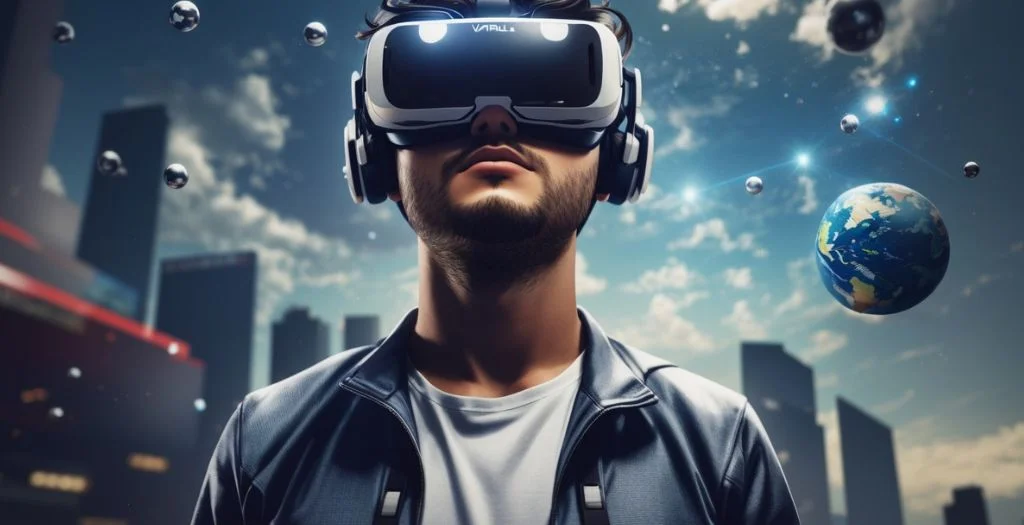Virtual reality (VR) is a system that simulates a 3D environment for user interaction. VR can be used for various purposes, such as entertainment, education, business, health, and social. VR can also enhance the perception and understanding of reality by adding or modifying sensory information. In this article, we will explore what virtual reality is, how it works, its types and applications, its benefits and challenges, and its future prospects.
History of Virtual Reality
People have known about the concept of virtual reality for a long time, but Jaron Lanier coined the term in 1987. He also founded one of the first companies to produce VR hardware and software. However, earlier inventions and experiments in various fields, such as art, literature, cinema, engineering, psychology, and military, inspired the roots of VR.
Some of the milestones in the history of VR are:
- In 1838, Charles Wheatstone invented the stereoscope, a device that used two images to create a 3D effect.
- In 1929, Edward Link developed the Link Trainer, a flight simulator that used motion feedback and realistic controls.
- In 1938, Antonin Artaud used the term “virtual reality” in his book The Theater and Its Double to describe the illusion of reality created by theater.
- In 1956, Morton Heilig patented the Sensorama, a machine that provided multisensory stimulation to create immersive experiences.
- In 1962, Ivan Sutherland created the Sketchpad, a computer program that allowed users to draw and manipulate 3D objects on a screen.
- In 1965, Ivan Sutherland proposed the concept of the Ultimate Display, a system that would simulate reality to the point of indistinguishability.
- Ivan Sutherland and Bob Sproull made the first HMD in 1968, a device that showed 3D images on two screens for the eyes.
Myron Krueger
- In 1977, Myron Krueger created Videoplace, an interactive installation that used computer vision and projection to create responsive environments.
- Michael McGreevy introduced the term “virtual environment” in 1984 to describe how users could explore computer-generated worlds.
- In 1985, Scott Fisher created the Virtual Environment Workstation (VIEW), a system that combined an HMD with a data glove and a voice synthesizer.
- Jaron Lanier coined “virtual reality” in 1989 and started VPL Research, a VR product company.
- In 1991, Sega released the Sega VR headset for arcade games and home consoles.
- In 1992, The Lawnmower Man movie featured VR technology and increased public awareness and interest in VR.
- In 1993, Sega announced the Sega VR-1 motion simulator for theme parks.
- In 1994, Sony released the Glasstron HMD for video games and movies.
- In 1995, Nintendo released the Virtual Boy console that displayed red-and-black 3D graphics.
- The Matrix movie showed a dystopian world in 1999 where a VR simulation trapped humans.
- In 2001, Google released Google Earth, a program that allowed users to explore satellite imagery of Earth in 3D.
- In 2007, Oculus Rift was a VR headset that offered high-resolution displays and low-latency head tracking.
Facebook acquired
- In 2014, Facebook acquired Oculus VR for $2 billion.
- In 2016, HTC released the Vive, a VR headset that used external sensors to track the user’s position and movement in a room-scale area.
- In 2016, Sony released the PlayStation VR, a VR headset that worked with the PlayStation 4 console.
- In 2017, Google released the Daydream View, a VR headset that used a smartphone as the display and controller.
- In 2018, Oculus released the Go, a standalone VR headset that did not require a PC or a smartphone.
- In 2019, Oculus released the Quest, a standalone VR headset that also supported room-scale tracking and hand tracking.
- In 2020, Microsoft released the HoloLens 2, a mixed-reality headset that projected holograms onto the user’s view of the real world.
Types of Virtual Reality
There are different types and methods of virtual reality, depending on the degree of immersion, interactivity, and realism that they provide. Some of the common types of VR are:
- Simulation-based VR: Computer models and algorithms simulate a realistic or abstract environment that the user can explore and manipulate in this type of VR. Training, education, gaming, and entertainment purposes can use simulation-based VR. Flight simulators, driving simulators, and virtual tours are examples of simulation-based VR.
- Immersive VR: Specialized devices, such as HMDs, motion controllers, and haptic feedback, create a realistic and immersive experience for the user. Immersive VR can evoke emotions and sensations. Oculus Rift, HTC Vive, and PlayStation VR are examples of immersive VR.
- Augmented reality (AR): This type of VR uses digital information, such as images, sounds, or text, to augment or enhance the user’s perception of the real world. AR can be used for various purposes, such as navigation, education, entertainment, and commerce. Examples of AR are Google Glass, Pokemon Go, and Snapchat filters.
- Mixed reality (MR): This type of VR combines elements of both VR and AR to create a hybrid experience that blends the real and virtual worlds. MR can allow the user to interact with both physical and digital objects in a seamless way. Examples of MR are Microsoft HoloLens, Magic Leap One, and Minecraft Earth.
Applications of Virtual Reality
Virtual reality has many applications in various domains and fields, such as:
- Entertainment: VR creates immersive and interactive experiences for entertainment purposes, such as video games, movies, music, art, and sports. VR also opens up new forms of storytelling and expression, such as 360-degree videos, virtual concerts, and social VR platforms.
- Education: VR can be used to enhance learning and teaching outcomes by providing engaging and interactive environments that can simulate various scenarios and concepts. VR can also enable access to remote or inaccessible locations, such as historical sites, museums, or outer space.
- Business: VR can be used to improve productivity and collaboration by enabling virtual meetings, presentations, and training sessions. VR can also enable new ways of marketing and selling products and services, such as virtual showrooms, tours, and demos.
- Health: VR provides therapy and rehab for conditions like pain, phobias, PTSD, ASD, and stroke. VR also enables new diagnosis and treatment methods, such as virtual surgery, telemedicine, and biofeedback.
- Social: VR enhances social interaction and communication by enabling virtual socialization, networking, and community building. VR also opens up new forms of identity exploration, expression, and empowerment, such as avatars, customization, and gamification.
Benefits and Challenges of Virtual Reality
Virtual reality has many benefits and challenges that need to be considered before adopting or using it. Several advantages of VR include:
- Immersion: VR can create a sense of immersion and presence for the user that can enhance their engagement, enjoyment, and motivation.
- Interactivity: VR can enable a high level of interactivity for the user that can enhance their agency, feedback, and learning.
- Accessibility: VR can enable access to remote or inaccessible locations, experiences, or information that would otherwise be difficult or impossible to obtain.
- Innovation: VR can enable new forms of innovation and creativity by providing novel tools , platforms, and opportunities for various purposes.
Some of the challenges of VR are:
- Cost: VR can be expensive to acquire, maintain, and update, depending on the type, quality, and complexity of the system.
- Safety: VR can pose safety risks for the user, such as physical injuries, cyberattacks, privacy breaches, or legal issues.
- Ethics: VR can pose ethical dilemmas for the user, such as moral responsibility, social impact, or psychological effects.
- Quality: VR can vary in quality depending on the technical specifications, design principles, content standards, or user preferences.
Virtual reality is a captivating and hopeful technology that can create simulated experiences that enhance our understanding and awareness of reality. VR has a long history and a broad range of types and applications that can benefit many domains and fields. VR also has many benefits and challenges that need to be considered before using or adopting it. Virtual reality is a rapidly growing field that has many potential innovations and directions that will shape its future. Virtual reality is a medium of expression, communication, and exploration that can enrich our lives in many ways.
Source: ZoxPR.

